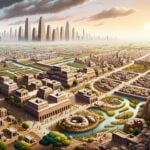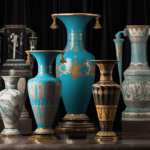Step back in time and embark on a mesmerizing journey into the awe-inspiring world of ancient India’s artistic brilliance. Delve into a realm where creativity knows no bounds and artistic achievements have left an indelible mark on the sands of time. In this captivating article, we will unveil the cultural wonders and extraordinary achievements that have made ancient India a beacon of artistic expression. From the intricate brush strokes of cave paintings to the ethereal beauty of sculptural masterpieces, get ready to immerse yourself in the rich tapestry of ancient India’s artistic legacy.
Ancient India Achievements in Art
The artistic traditions of ancient India have left an indelible mark on the world, with their brilliance and cultural significance resonating through the ages. From intricate cave paintings to awe-inspiring temple architecture, ancient Indian art showcases the rich tapestry of creativity, spirituality, and technical mastery that defined this flourishing civilization. In this article, we will delve into the remarkable achievements of ancient India in the realm of art and uncover the profound cultural legacy they have bestowed upon us.
Ancient India: A Cradle of Artistic Diversity
Ancient India was a melting pot of diverse civilizations, each leaving its unique imprint on the artistic landscape. From the Harappan civilization in the Indus Valley to the mighty Gupta Empire, these ancient societies flourished and nurtured a plethora of artistic expressions. This rich diversity is evident in the various art forms that emerged, encompassing sculpture, painting, architecture, and more. But what makes these artistic achievements in ancient India truly remarkable? Let’s explore further.
Sculptural Splendor: A Testament to Skill and Spirituality
In the realm of sculptural art, ancient India reached unparalleled heights of technical excellence and spiritual devotion. The intricate stone carvings that adorn ancient temples and caves bear testimony to the immense skill and artistry of the sculptors. From the mesmerizing sculptures at the Ellora and Ajanta Caves to the iconic temples of Khajuraho and Konark, the sculptural brilliance of ancient India captivates the imagination. But what lies beyond the exquisite craftsmanship?
These sculptures are not mere artistic creations; they embody deep spiritual and religious symbolism. Each sculpture tells a sacred story, often drawn from Hindu mythology, and conveys profound philosophical ideas. The expertly carved expressions and gestures of deities, heroes, and mythical creatures convey emotions, narratives, and cosmic truths. As the viewer admires these sculptures, they are transported into a world where the divine and the human converge, offering a glimpse into ancient India’s spiritual and cultural ethos. As the great philosopher Ralph Waldo Emerson said, “Art is the path to the highest truths.”
Key Point: The sculptural brilliance of ancient India lies not only in their technical finesse but also in their spiritual symbolism, immortalizing the deep religious and philosophical beliefs of the civilization.
The Painted Tales: Unveiling Ancient India’s Artistic Narrative
While sculptures may steal the limelight, ancient India’s artistic achievements are not confined to stone alone. The cave paintings that adorn the walls of Ajanta, Ellora, and Bhimbetka provide a vibrant and colorful glimpse into the ancient world. These paintings depict a wide range of subjects, from religious and mythological narratives to scenes of everyday life. They serve as visual chronicles, chronicling the stories, beliefs, and social dynamics of ancient India.
The artistic brilliance of these cave paintings lies not only in their subject matter but also in their execution. The meticulous blending of vibrant colors, the intricate details, and the delicate brushwork showcase the technical mastery of ancient Indian artists. These paintings are not confined to a flat surface; they engage the viewer, creating an immersive experience that transcends time and space. As the French painter Edgar Degas once said, “Art is not what you see, but what you make others see.”
Key Point: Ancient India’s cave paintings are not mere illustrations but vivid narratives that bring alive the stories, beliefs, and social fabric of the ancient world.
Architectural Marvels: Constructing Sacred Spaces
No exploration of ancient India’s artistic achievements is complete without acknowledging its architectural marvels. From the iconic temples of South India to the magnificent forts and palaces of Rajasthan, ancient Indian architecture stands as a testament to the grandeur and ingenuity of the civilization. The intricate carvings, the soaring pillars, and the harmonious proportions of these structures reflect the profound understanding of aesthetics and engineering possessed by ancient Indian architects.
The architecture of ancient India not only served as a means to create awe-inspiring structures but also as a vehicle for spiritual transcendence. The temples, with their intricate sculptures and elaborate rituals, were designed to be sacred spaces, where humans could commune with the divine. The ancient Indian architects skillfully blended art, science, and spirituality to create spaces that evoked a transcendent experience, just as the renowned architect Frank Lloyd Wright once said, “The mother art is architecture.”
Key Point: Ancient Indian architecture goes beyond its functional purpose; it is a symbiotic blend of art, science, and spirituality, creating sacred spaces that inspire awe and foster a connection with the divine.
In conclusion, the artistic achievements of ancient India in sculpture, painting, and architecture reveal a civilization that celebrated diversity, spirituality, and technical brilliance. Each artistic form offered a window into the rich cultural tapestry of the time, providing insights into mythology, philosophy, and social dynamics. As we explore the artistic brilliance of ancient India, we deepen our understanding and appreciation of the cultural heritage that has shaped us. So, let us embark on this journey through time and immerse ourselves in the resplendent artistry of ancient India.
**Key Takeaway: Ancient India’s art forms – sculptures, paintings, and architecture – are a testament to the civilization’s diverse creativity, spiritual devotion, and technical mastery. They provide insights into ancient beliefs, narratives, and the grandeur of the time. It’s a journey through time that connects us with our cultural roots.
Ancient India was a land of astonishing achievements that continue to mesmerize us even today. From groundbreaking discoveries in mathematics and science to monumental architectural feats, the people of ancient India left an indelible mark on history. Step back in time and explore the incredible accomplishments of this enchanting civilization. Discover the wonders of ancient India achievements here.
Achievements of Ancient India: A Glimpse into a Civilization’s Legacy
[youtube v=”Pdwz51xkmkU”]
Development of Ancient India Architecture and Water Systems
Ancient India was a melting pot of diverse civilizations, each leaving its unique imprint on the artistic landscape. The achievements of ancient India encompassed various aspects, including architecture and water systems within city structures. The ancient infrastructure of Indian trade routes and the influence of foreign peoples on ancient India’s culture were also significant.
The sculptural brilliance of ancient India lies not only in their technical finesse but also in their spiritual symbolism. Cave paintings in ancient India depict religious and mythological narratives as well as everyday life, providing a glimpse into the ancient world. The artistic achievements of ancient India celebrate diversity, spirituality, and technical brilliance.
Ancient Indian cities like Harappa and Mohenjo-Daro were known for their impressive and organized layout. The houses in these cities featured plumbing systems, including baths, toilets, running water, and drains. Elaborate fountains and pools were also discovered in these cities, although their exact purpose remains unknown. Historians speculate that they might have served as bathing areas and social spaces for the upper class.
“The great baths in the ancient city of Mohenjo-Daro were heated and are believed to be the first invented stepwell or steps leading down into a man-made reservoir” (-Instructomania). The ancient Indians had great knowledge of tides and skills in surveying and mapping waterways. Their expertise in utilizing the ever-changing rivers, lakes, and coastal waters played a vital role in promoting trade.
Infrastructure of Indian Trade Routes
Ancient Indian trade routes were crucial in connecting different regions and facilitating the exchange of goods and ideas. The trade routes included suspension bridges made of braided bamboo and iron chains, which helped merchants traverse difficult terrains. These bridges were evidence of the advanced engineering skills possessed by ancient Indians.
Additionally, ancient Indians harvested various crops, including wheat, barley, rice, cotton, peas, dates, and melons. The introduction of new crops, such as cotton and sugarcane, occurred after the migration of the Aryans or indo-europeans into northern India. The collaboration between the Harappans and the Aryans led to the creation of a more advanced agrarian society.
Ancient Indians were also known for their inventions and advancements in different fields. For instance, the Harappan culture developed ink made from burned animal bones, tar, and tree sap. This ink was used as early as 500 to 400 BCE and was imprinted on metals and stones to create a written language that is still not completely deciphered.
Influence of Foreign Peoples on Ancient India’s Culture
The arrival of the Aryans brought significant changes to ancient India’s culture. They introduced horses, chariots, and wheeled transportation, which helped them expand their territory and strengthen their army. Sailboats with a single mast and sail were also utilized for navigation and trade with Africa and throughout Asia. The Gupta Empire, which thrived from 310 to 600 CE, marked India’s Golden Age and witnessed major advancements in mathematics, art, literature, medicine, and astronomy.
“The first known cataract surgery was performed by the physician Sushruta in the 6th century BCE” (-Instructomania). This surgical procedure involved removing a foggy lens that caused blurry vision or blindness. Sushruta’s innovative technique of inserting a needle into the eye to lift the lens and push the cataract out of the line of vision spread from India to China and further developed there.
In summary, ancient India’s achievements are a testament to its rich cultural heritage and technical prowess. From the complex city layouts and advanced plumbing systems to the construction of trade routes and advancements in agriculture, ancient Indians laid the foundation for future civilizations.
“They left behind a legacy that continues to inspire and awe us, showcasing the ingenuity and creative spirit of ancient India” (-Anonymous).
FAQ
Question 1
What are some examples of ancient Indian art forms?
Answer 1
Ancient Indian art forms include cave paintings, sculptural masterpieces, and intricate temple architecture.
Question 2
What is the significance of ancient Indian art?
Answer 2
Ancient Indian art holds immense cultural, religious, and historical significance. It reflects the diverse artistic traditions and achievements of ancient civilizations in India.
Question 3
How did the COVID-19 pandemic impact remote learning?
Answer 3
The COVID-19 pandemic disrupted the global education system, leading to the adoption of remote learning. This shift posed challenges such as the digital divide and mental health concerns among students.
Question 4
What advantages did remote learning bring?
Answer 4
Remote learning provided opportunities for personalized learning and global collaboration. Students could access a wide range of educational resources and engage in virtual group projects, enhancing teamwork and cultural competence.
Question 5
What steps can be taken to improve remote learning in the future?
Answer 5
To improve remote learning, it is essential to address the digital divide by investing in digital infrastructure and ensuring broadband accessibility for all students. Additionally, providing teacher training and support, as well as prioritizing student well-being and mental health, are crucial steps in creating a more inclusive and resilient education system.















